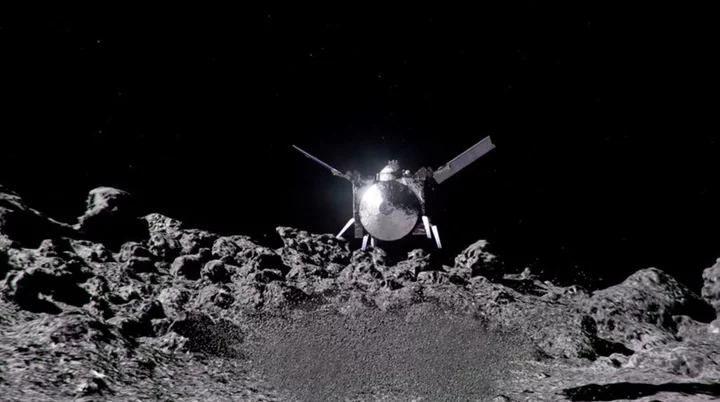By Steve Gorman
About 5-1/2 years from now, astronomers predict, an asteroid about as wide as the Empire State Building is tall will streak through space within 20,000 miles (32,200 km) of Earth, the closest any celestial object of that size will have come to our planet in modern history.
When it does, a spacecraft launched by NASA in 2016 is expected to be in position to provide a detailed examination of this rare close encounter.
The mission, directed by University of Arizona scientists, is expected to yield insights into planetary formation and knowledge that could inform efforts to build a defense system against possible doomsday asteroid collisions with Earth.
At the time of its 2004 discovery, the asteroid Apophis, named for a demon serpent embodying evil and chaos in ancient Egyptian mythology, appeared to pose a dire impact threat to Earth, with scientists forecasting a potential collision in 2029. Refined observations have since ruled out any impact risk for at least another century.
Still, its next approach in 2029 will bring the asteroid within a cosmic cat's whisker of Earth - less than one-tenth the moon's distance from us and well within the orbits of some geosynchronous Earth satellites.
The spacecraft now headed for a rendezvous with Apophis is OSIRIS-REx, which made headlines plucking a soil sample from a different asteroid three years ago and sending it back to Earth in a capsule that made a parachute landing in Utah in September.
SPACECRAFT'S SECOND ACT
Rather than retire the spacecraft, NASA has rebranded it as OSIRIS-APEX - short for APophis EXplorer - and fired its thrusters to put it on course for its next target.
The Apophis expedition was detailed in a mission overview published in the Planetary Science Journal.
Apophis, oblong and somewhat peanut-shaped, is a stony asteroid believed to consist mostly of silicate materials along with iron and nickel. Measuring about 1,110 feet (340 meters) across, it is due to pass within about 19,800 miles (31,860 km) of Earth's surface on April 13, 2029, becoming visible to the naked eye for a few hours, said Michael Nolan, deputy principal investigator for the mission at the University of Arizona.
"It's not going to be this glorious show," Nolan said, but it will appear as a point of reflected sunlight in the night sky over Africa and Europe.
An asteroid that large passing so near to Earth is estimated to occur roughly once every 7,500 years. The Apophis flyby is the first such encounter predicted in advance.
The tidal pull of Earth's gravity likely will cause measurable disturbances to the asteroid's surface and motion, changing its orbital path and rotational spin. Tidal forces could trigger landslides on Apophis and dislodge rocks and dust particles to create a comet-like tail.
The spacecraft is set to observe the asteroid's Earth flyby as it nears and ultimately catches up with Apophis. These images and data would be combined with ground-based telescope measurements to detect and quantify how Apophis was altered as it passed by Earth.
OSIRIS-APEX is scheduled to remain near Apophis for 18 months - orbiting, maneuvering around it and even hovering just over its surface, using rocket thrusters to kick up loose material and reveal what lies beneath.
PLANETARY SCIENCE AND DEFENSE
Like other asteroids, Apophis is a relic of the early solar system. Its mineralogy and chemistry are largely unchanged in more than 4.5 billion years, offering clues to the origin and development of rocky planets like Earth.
Close examination of Apophis could give planetary defense experts valuable information about the structure and other properties of asteroids. The more scientists know about the composition, density and orbital behavior of such celestial "rubble piles," the greater the chances of devising effective asteroid-deflection strategies to mitigate impact threats.
NASA deliberately crashed a spacecraft into a small asteroid last year in a planetary-defense test that nudged the rocky object from its normal path, marking the first time humankind altered the natural motion of a celestial body.
Apophis is substantially larger than that asteroid but tiny compared with the one that struck Earth 66 million years ago, wiping out the dinosaurs.
While not big enough to pose an existential threat to life on Earth, an Apophis-sized asteroid striking the planet at hypersonic speed still could devastate a major city or region, Nolan said, with ocean impact unleashing tsunamis.
"It wouldn't be globally catastrophic in the sense of mass extinctions," but an impact "would definitely come under the category of bad," Nolan said.
"This thing is coming in at many miles per second if it hits. And at that speed, it kind of doesn't whether if it's made of gravel or ice or rocks or whatever. It's just a big, heavy thing moving fast," Nolan added.
(Reporting by Steve Gorman in Los Angeles; Editing by Will Dunham)

